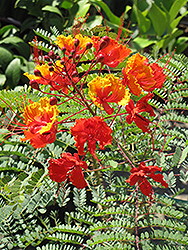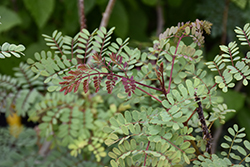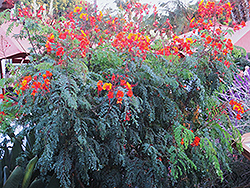It's all about ...
plants

Mexican Bird Of Paradise
Caesalpinia pulcherrima
Height: 15 feet
Spread: 10 feet
Sunlight:
![]()
Hardiness Zone: 9b
Other Names: Barbados Pride, Peacock Flower, Poinciana
Description:
This tropical shrub or small tree produces spectacular upright racemes of luminous yellow, orange, and red blooms that are long lasting; graceful foliage creates a wonderful texture; perfect for patio containers, or near walkways
Ornamental Features
Mexican Bird Of Paradise's attractive tiny oval bipinnately compound leaves emerge light green in spring, turning bluish-green in colour the rest of the year on a plant with an upright spreading habit of growth. The fruits are showy tan pods displayed from early fall to early winter.
Landscape Attributes
Mexican Bird Of Paradise is an open multi-stemmed evergreen tropical plant with an upright spreading habit of growth. It brings an extremely fine and delicate texture to the garden composition and should be used to full effect.
This is a relatively low maintenance plant, and should only be pruned after flowering to avoid removing any of the current season's flowers. It is a good choice for attracting bees, butterflies and hummingbirds to your yard. Gardeners should be aware of the following characteristic(s) that may warrant special consideration;
- Spiny
Mexican Bird Of Paradise is recommended for the following landscape applications;
- Mass Planting
- Hedges/Screening
- General Garden Use
- Naturalizing And Woodland Gardens
- Container Planting
Planting & Growing
This plant is native to the tropics and prefers growing in moist environments with evenly warm conditions all year round. In our climate, it is usually grown as an outdoor annual in the garden or in a container. If you want it to survive the winter, it can be brought in to the house and provided with special care, and then returned to the garden the following season. In its preferred tropical habitat, it can grow to be around 15 feet tall at maturity, with a spread of 10 feet. However, when grown as an annual or when overwintered indoors, it can be expected to perform differently, and its exact height and spread will depend on many factors; you may wish to consult with our experts as to how it might perform in your specific application and growing conditions.
This plant should only be grown in full sunlight. It prefers to grow in average to moist conditions, and shouldn't be allowed to dry out. It is not particular as to soil pH, but grows best in rich soils. It is somewhat tolerant of urban pollution. This species is not originally from North America.
Mexican Bird Of Paradise is a fine choice for the garden, but it is also a good selection for planting in outdoor pots and containers. Its large size and upright habit of growth lend it for use as a solitary accent, or in a composition surrounded by smaller plants around the base and those that spill over the edges. It is even sizeable enough that it can be grown alone in a suitable container. Note that when growing plants in outdoor containers and baskets, they may require more frequent waterings than they would in the yard or garden. Be aware that in our climate, most plants cannot be expected to survive the winter if left in containers outdoors, and this plant is no exception. Contact our experts for more information on how to protect it over the winter months.
-- THIS IS A TROPICAL PLANT AND SHOULD NOT BE EXPECTED TO SURVIVE THE WINTER OUTDOORS IN OUR CLIMATE --


